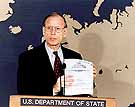
|
|
|

|

|

|

|
|
Click on an image to see a larger, more detailed picture.
|
|
|
|
|
| EPILOGUE: The Aftermath |

|
pg. 694 |

|
|
|
|
| |
|
Drucker's pursuit was frustrated at every turn. The insurance companies would not honor her claims. On one occasion, she was told that her father had failed to make the premium payments that would have kept the policies in force. Other "explanations" for rejecting the claims filed by Drucker and claimants like her ranged from "the insurance company no longer exists," "the relevant records were destroyed by the war," or "the Communists nationalized the company" to "nothing can be done without a death certificate." Thinking her cause was lost, Drucker immigrated to the United States in 1964. In 1997 she traveled to Washington, D.C., where she told her story to a group of insurance regulators. The regulators were committed to helping her and the many other Holocaust survivors and heirs who were seeking restitution from major insurers such as Allianz, Winterthur, and Generali for $1 billion of unpaid insurance claims.
|
 U.S. Undersecretary of Commerce Stuart Eizenstat publicizes a massive report in May 1997, which harshly condemns Switzerland for dealing in Nazi gold during WWII.
U.S. Undersecretary of Commerce Stuart Eizenstat publicizes a massive report in May 1997, which harshly condemns Switzerland for dealing in Nazi gold during WWII.
Photo: Reuters/Mike Theiler/Archive Photos
|
|
Stuart Eizenstat's report indicated that "the issue of Holocaust-era insurance claims was one of the most complex and difficult challenges facing the Washington Conference." The report announced that "a fast track for payments to Holocaust survivors" is being pursued, but few would contest his judgment when he added that "there's more to be done."
|
 These Sinti (Gypsy) survivors went on a hunger strike at Dachau, Germany, in 1980. They demanded moral rehabilitation for their suffering during the Holocaust.
These Sinti (Gypsy) survivors went on a hunger strike at Dachau, Germany, in 1980. They demanded moral rehabilitation for their suffering during the Holocaust.
Photo: Wide World Photo
|
|
Never Forget The Washington Conference also stressed that more needs to be done for research, education, and remembrance about the Holocaust. "It's important," Eizenstat underscored in his report, "that the last word on the Holocaust for this century not be money alone." Restitution plans include using portions of the heirless assets for international educational initiatives that make increased Holocaust awareness a priority. Without significant education, the Holocaust will be forgotten.
|
|

|

|

|

|
 November 9, 1997: A Holocaust memorial museum opens at Sachsenhausen, Germany, site of a Nazi-era concentration camp.
November 9, 1997: A Holocaust memorial museum opens at Sachsenhausen, Germany, site of a Nazi-era concentration camp.
|
 November 13, 1997: Spurred by Jewish protest, Germany's parliament votes to stop government disability checks for suspected Nazi war criminals. Some 50,000 German veterans suspected of war crimes, including members of the Waffen-SS, have been receiving benefits.
November 13, 1997: Spurred by Jewish protest, Germany's parliament votes to stop government disability checks for suspected Nazi war criminals. Some 50,000 German veterans suspected of war crimes, including members of the Waffen-SS, have been receiving benefits.
|
 Late November 1997: Two safe-deposit boxes opened at a bank in Sao Paulo, Brazil, contain documents suggesting that assets stolen by Nazis were secretly channeled to Brazilian banks.
Late November 1997: Two safe-deposit boxes opened at a bank in Sao Paulo, Brazil, contain documents suggesting that assets stolen by Nazis were secretly channeled to Brazilian banks.
|
 December 1997: The Federal Reserve Bank of New York makes public secret documents showing that, early in 1952, the bank took possession of gold plates, buttons, coins, and smoking-pipe ornaments that had been stolen from victims of Nazi persecution, and later melted them into gold bars that were given to European central banks.
December 1997: The Federal Reserve Bank of New York makes public secret documents showing that, early in 1952, the bank took possession of gold plates, buttons, coins, and smoking-pipe ornaments that had been stolen from victims of Nazi persecution, and later melted them into gold bars that were given to European central banks.
|
 December 1997: The U.S. State Department sets a deadline of the end of the century for completion of German reparations payments to victims of Nazi looting during the Holocaust.
December 1997: The U.S. State Department sets a deadline of the end of the century for completion of German reparations payments to victims of Nazi looting during the Holocaust.
|
|
|
|
|
| EPILOGUE: The Aftermath |

|
pg. 694 |

|
|
The Holocaust Chronicle
© 2009 Publications International, Ltd.
|
|
